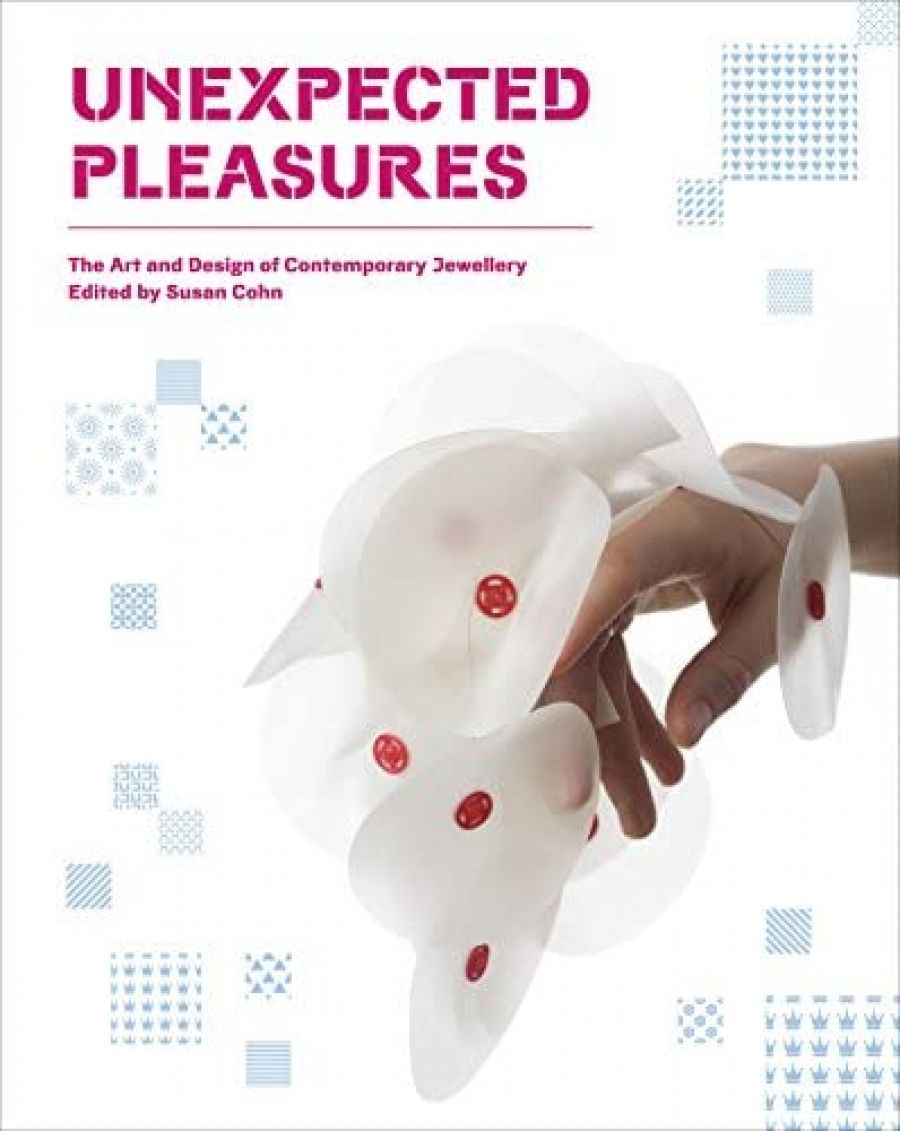
- Free Article: No
- Contents Category: Art
- Review Article: Yes
- Online Only: No
- Custom Highlight Text:
The contemporary jewellery movement grew from a desire among postwar practitioners to explore both the expressive qualities in jewellery and the use of non-traditional materials. The move away from traditional gold and diamonds was partly economic – consider today’s price of gold – and partly ideological. Jewellery should be appreciated for what it is, on its own terms, not for its carats.
- Book 1 Title: Unexpected Pleasures
- Book 1 Subtitle: The Art and Design of Contemporary Jewellery
- Book 1 Biblio: Rizzoli (Hardie Grant Books), $75 hb, 240 pp
Unexpected Pleasures: The Art and Design of Contemporary Jewellery, an exhibition and book, offers a truly international survey of recent art jewellery. Susan Cohn – editor and contributing author of the book, and curator of the exhibition – has ranged widely in her selection of makers, techniques, and approaches. She does not attempt to provide the last word on the subject; rather, she considers different propositions and draws on her own experiences at the work bench and on her considerable research. As Cohn puts it: ‘I have applied a maker’s approach to exploring ideas.’
Jewellery and all forms of personal adornment are about self-image, how we view ourselves, how we wish to present ourselves privately and publicly. Of all the areas of decorative arts and design, only jewellery, along with costume, comes alive with the body. It is this relationship that the owner and wearer has with jewellery that fascinates Cohn:
My interests as a maker are inseparable from my social instincts. Through years of practice I have developed a kind of voyeurism based around jewellery’s codes […] A focus on craftsmanship, precious materials and the beauty in making will only uncover the more visible dimension in jewellery’s relationship to people.
An inherent problem with much contemporary jewellery is that, while eschewing associations with wealth and privilege, it creates, as does so much contemporary art, a different élite – the cognoscenti who recognise it and understand its codes. And while the materials of contemporary jewellery might be democratic, its conceptual nature can be demanding. Don’t just think of rings, necklaces, brooches, and tiaras, or even lanyards (ubiquitous nowadays, especially at sporting events, and often worn proudly for hours afterwards), security passes, and military medals, but consider bandages, picture frames, as well as marks left on the body when jewellery is removed. Having appeared on an ABC radio panel to discuss this exhibition with Cohn and Julia de Ville, an artist whose work appears in the exhibition, I can attest that some contemporary jewellery is not for the squeamish. De Ville is also a taxidermist, and her freezers are full of ethically sourced dead animals awaiting her treatment. She explained on the radio that she had just acquired a chest freezer to accommodate a stillborn calf someone had given her.

Deyan Sudjic, director of London’s Design Museum, gives a potted narrative of the cultural position of objects and their design, with reference to writers such as Adolf Loos (‘ornament is crime’) and Thorstein Veblen (‘conspicuous consumption’). Further essays by Glenn Adamson, Liesbeth den Besten, Peter Dormer, and Cohn expand on ways of looking at and understanding contemporary jewellery. The complex colour-coded design of this extensively illustrated book incorporates three sections and eight chapters, making it a considerable reference work as well as an exhibition catalogue. The design and layout appear to borrow from the conventions of Web design. For instance, the extensive cross-references to artists, works, and related themes covered elsewhere in the volume are underlined in the manner we now all recognise and click on when using the Internet. The inclusion of the work of a large number of Australian practitioners is clear evidence of the healthy state of jewellery making in this country.
As curator of Unexpected Pleasures, Susan Cohn rightly, and laudably, excludes her own work from the exhibition. However, this does mean that the survey does not represent the work of one of Australia’s finest practitioners. Cohn’s elegantly resolved, beautifully crafted, and thoughtful jewellery has that rare combination of being both conceptually rigorous and desirable at the same time. While her work could not be included in the exhibition, the small selection of her pieces illustrated in the book is entirely appropriate for the context of the visual argument being presented.
Unexpected Pleasures is at the National Gallery of Victoria until 26 August, then at the Design Museum, London, between 5 December 2012 and 3 March 2013.


Comments powered by CComment